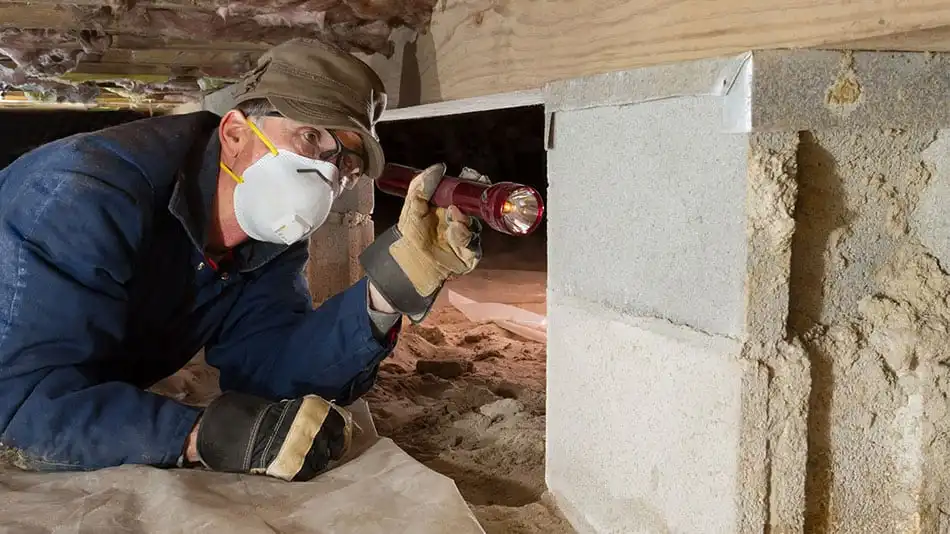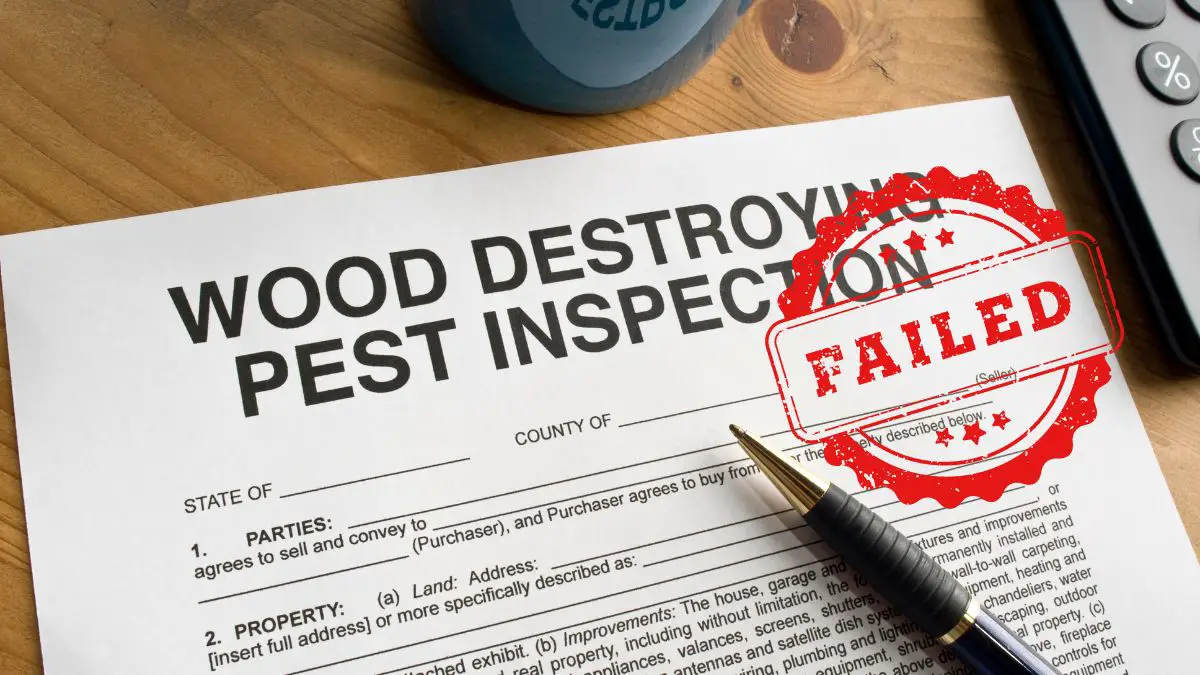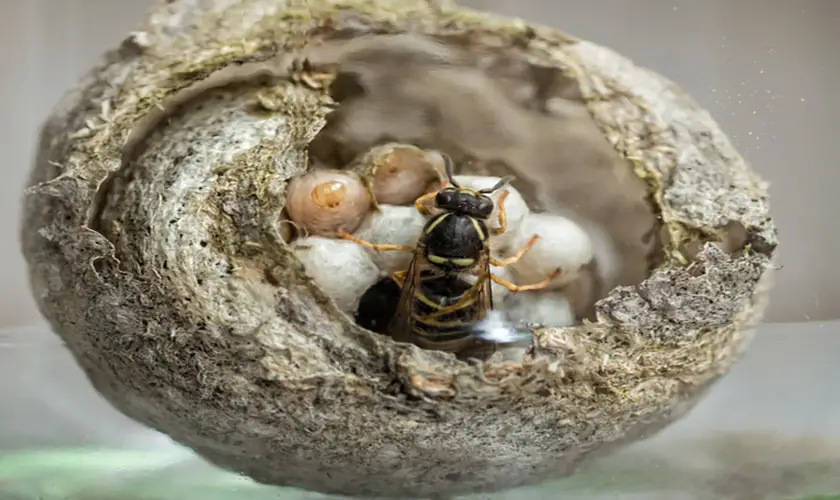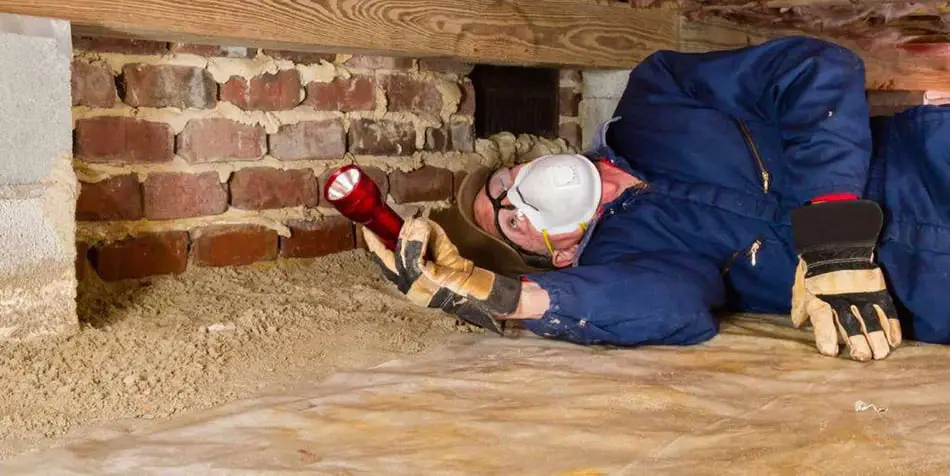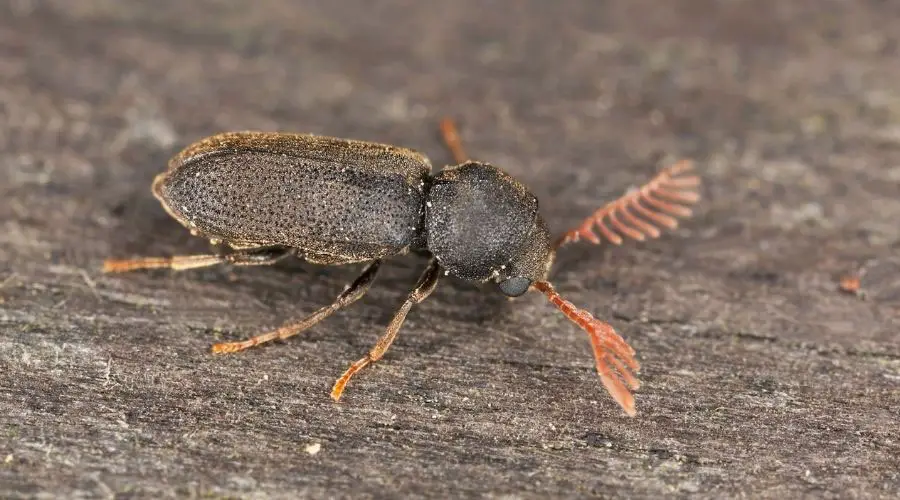
Wood borers are capable of causing significant destruction to your tree, your home, or any wood product available to them. Some live under the bark of trees, some bore into the tree trunk, while others live in the tree’s root system. Lumber is not immune from infestation from these pests, and once they move in, they can be difficult to remove!
Prevention methods are the best way to protect your wood from wood borers, but if you do have an infestation, there are ways that you can eliminate them. Try these four treatments for eradicating wood borers.
- The chemical route
- The eco-friendly way
- DIY methods
- The natural way
Get FREE quotes from licensed pest control technicians in your area today. Whether you need spraying for ants, roaches, spiders, ticks, mosquitos, or bed bugs, We Can Help! All technicians are screened, licensed, and insured.
Wood-boring insects are classified as pests because of the destruction that they cause. By watching for the signs of these destructive insects, you should be able to eliminate them before they cause too much damage to your home. There are methods to stop them and ensure they don’t return in more significant numbers.
What Are Wood Borers?
Wood borers are a large family of insects who eat and destroy wood, trees, and shrubs. Certain beetles, moths, and wasps are the most common borers, with some species causing more damage than others.
While some species only attack stressed trees damaged due to drought, disease, or injury, others will attack and damage healthy trees and wood.
Other wood borers attack healthy trees, plants, and shrubs or infest lumber in lumberyards. These borers are primary invaders as they could eventually kill the tree by boring into its inner bark layer.
This layer transports water and nutrients to the leaves, and the tree will die either above or below the wrapped site when it is completely encircled.
Tree growth can be stunted above the encircled site, and limbs and branches can occasionally fall off the tree. The tree can become susceptible to diseases that could affect the quality of the lumber.
Secondary invaders will only attack a plant after being weakened by stress and may contribute to the death of the plant, tree, or shrub.
Wood-borer-infested wooden structures like decks, hardwood floors, support beams, and furniture will be covered in holes and tunnels, causing the strength of the wood to be compromised and eventually fall apart!
Adult beetles lay their eggs in holes and cracks in the wood. Once the eggs hatch into larvae, they eat their way out through the wood over many years.
Some wood borers, especially in forest settings, are beneficial as they assist in recycling the nutrients in dead and dying trees. Mature wood-borers require nutrients provided by fungi growing on the wood to develop.
These nutrients pass through the body of the borer and are expelled in their frass. It is then absorbed by the soil and recycled back into the trees and foliage in the forest.
The 4 Best Treatments For Wood-Borers
By following our guides on spotting a wood-borer infestation and identifying borers, you should have a rough idea of which borer you are dealing with.
Follow these steps first before taking any steps to eliminate wood-borers.
- Identify them correctly to know which pest you are dealing with. For example, termites could be confused with borers but need a different treatment to eliminate them.
Unfortunately, it can often be challenging to identify borers as they are generally hidden beneath the surface of the wood. - Check that you have a current active infestation. If the damage is old, you don’t have to treat it. Check for fresh frass and live larvae or adults in the wood.
- Always inspect the trees first to see what the damage is. Trees that are heavily infested or damaged by tree borers should always be removed. However, trees that have a minor infestation could be worth saving.
Once you have correctly identified the wood borer, various treatments exist to eliminate them.

1. The Chemical Route To Eliminate Wood-Borers
Insecticides are generally used to eliminate wood borers and fight insect infestations. Always call a professional exterminator with the knowledge to treat the pests.
Chemical treatments might not be necessary unless you see actual borers or fresh wood powder around the holes. The new wood powder does not clump and is light in color, whereas the old wood powder clumps together and is yellow.
You might find damage to the wood caused by borers, but they could have already left or died, so no treatment is necessary.
There are various ways that you can eliminate these pests:
Fumigation Methods To Use On Borers
Fumigation might be advisable for heavily infested areas, especially when other manual elimination methods have failed or the borers need to be removed quickly.
Also, fumigation is often used when the infestation is hard to get to an area like cramped crawlspaces.
The downside of fumigation is that the treatment will not last or prevent future re-infestations from eggs laid by adult borers. In addition, fumigation is very expensive and can only be performed by licensed fumigation experts.
Insecticides To Use On Borers
If you have decided to call in professionals to get rid of your borer infestation, they will use any one of several insecticide treatments to eliminate the problem.
- Insecticide treatment. This is a synthetic pyrethroid insecticide containing the active ingredient Cypermethrin. This insecticide is successful in preventing borers from infesting trees and shrubs.
The best time to apply this insecticide treatment is before the larvae hatch and begin to tunnel into the bark. Then, the insecticide will be sprayed over the tree trunk and branches, saturating any holes visible in the wood. - Soil treatment. After the tree has been treated with insecticide, the soil around the tree needs to be treated. Syngenta 25001 Demon Max Insecticide is a systemic insecticide solution which means that when applied to the soil, it will enter the tree by the roots and help to control tree borers that may try to burrow into or feast on the tree. Therefore, you should drench the soil around the tree’s base with the insecticide.

2. The Eco-Friendly Way To Eliminate Wood Borers
If you don’t want toxins around your home or garden, there are safer ways to eliminate wood-borers from your home and property. Try these non-toxic ways to get rid of them.
- Heat treatments. Placing your furniture in direct sunlight should dry out any moisture from the wood and prevent further infestations. Temperatures around 140 degrees Fahrenheit (60 degrees Celsius) should be hot enough to eradicate wood-borer infestations.
- Freezing treatments. You should eliminate the wood borer larvae by wrapping the infected wood in plastic and placing it inside a walk-in freezer.
Wood-borers can survive in freezing temperatures, so by deep-freezing them quickly at temperatures below -4 degrees Fahrenheit (-20 degrees Celsius), they should be killed off after about two weeks.
Be careful when handling the furniture as the glue in the joints will become fragile when frozen. - Central heating and air-conditioning can significantly decrease infestations by borers. Therefore, serious borer problems are not very likely if the house has a cooling and heating system and the moisture in the home is controlled. However, if you do have borers, you can eliminate them relatively quickly.
- Most borers are attracted by moisture in the lumber. Moisture problems occur in crawl spaces because they are not well ventilated.
Placing a plastic barrier sheet over the ground in the crawl space can prevent the lumber from getting too moist and attracting borers. Paint and water sealants can protect the wood from moisture and borer problems. - Surface treatments won’t help if the lumber is already infested. However, if you see signs of infestation, remove the pieces of lumber from the pile and get rid of them.
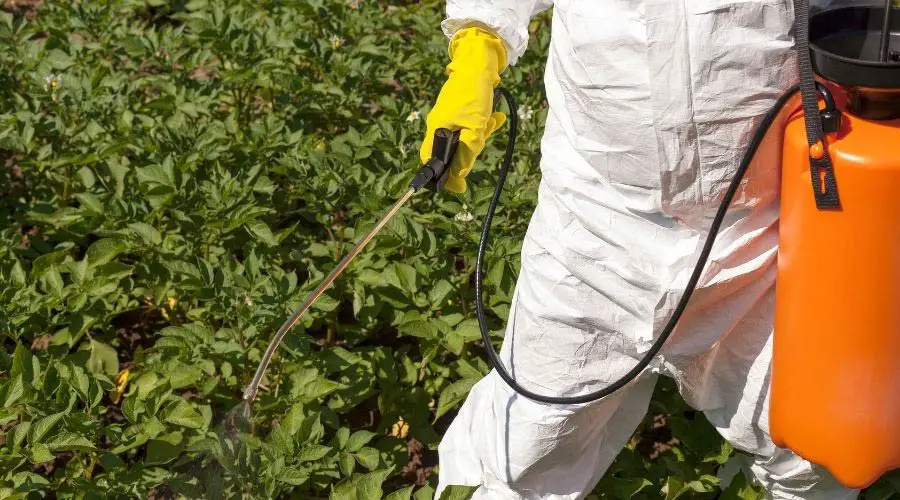
3. DIY Methods To Treat Wood-Borer Infestations
Always use personal protection gear when handling insecticides, and follow the directions on the packaging.
A limited range of insecticides is available to the public, with a broader range only available to professional exterminators. Pay a visit to your neighborhood garden center to see which products are available to eradicate wood borers from your home.
Before applying any insecticides to the affected area, strip any paint off the item so that the insecticide can penetrate the wood properly.
Make sure you choose a product containing the chemical Borate to prevent wood borers from eating wood. Bifenthrin insecticide products can be used to attack wood borers inside your home but will not eradicate them from wood.
Watch the video below on how to effectively treat wood borers in your home.
4. Natural Methods To Treat Wood-Borer Infestations
Not all treatments involve using pesticides or chemicals to remove wood borers. Sometimes, no treatments are necessary as the borer will die or go away on its own. In addition, wood-borers are harmless to humans and cannot infest treated wood.
The best way to treat and manage these pests is by prevention methods. If you see any beetles, eggs, or larvae, physically remove them by hand or using a vacuum cleaner.
There are a few natural remedies that you can use to keep borers away:
Diatomaceous Earth
Diatomaceous earth is an excellent non-toxic solution to borer problems. Sprinkle the powder over the infected areas. Any borers which come into contact with the powder will die immediately.
Keep sprinkling around the infected area for a few weeks to ensure you get all the adult beetles.
Garlic
Garlic is a great, non-toxic pesticide that is offensive and hazardous to most insects. Follow this recipe to make an effective pesticide that will kill both male and female borers but will only kill the eggs if the solution is strong enough. Here are the ingredients that you would need:
- Garlic cloves
- Chili flakes
- Water
- A spray bottle
How do you make the solution?
- Crush the garlic cloves into a paste.
- Add water and chili flakes to the garlic paste and allow to sit overnight.
- Add more water to make a thin liquid.
- Pour into a spray bottle.
- Spray the solution into every visible hole as well as cracks and crevices.
- The garlic will irritate and kill the borer beetles, and the chili will burn them and make life unbearable.
How To Prevent Wood-Borer Infestations
Prevention is the best management treatment when it comes to wood borers. If you do find signs of borers, deal with them immediately! Follow these simple steps to keep the wood borers from returning once they have been treated.
1. In Your Home
Infestations occur in areas with high humidity, so ensure that your home is adequately ventilated or heated to prevent them from being an ideal environment.
- Permanently remove infested furniture from your home. If you cannot salvage it, burn it to stop the infestation spread.
- Sometimes wood-borers may arrive in your firewood without your knowledge. Always leave the wood outside in an unheated shed or the garage to prevent an infestation. Only bring a small amount into the house as needed.
- Always inspect the wood before purchasing and bringing it into your home.
- Only buy kiln or air-dried wood to ensure the wood is not already infested.
- Use chemically treated wood and lumber.
- Brush unprotected wood with insecticide to stop the infestation before it starts.
2. At The Construction Site
The wood supplier or the timber mill must take precautions to prevent the wood from becoming infested with borers. Once the lumber reaches the construction site or storage area, you should take the following precautions to ensure that the lumber remains borer free:
- Inspect all the lumber before using it.
- Seal all wood surfaces and protect them from moisture.
- Store the lumber away from the ground and buildings in a well-ventilated area.
- Protect the lumber with plastic sheeting or tarps.
- Only use chemically treated lumber to prevent borer infestations.
How Do Wood-Borers Get Into My Home?
There are many ways that wood-borers enter your home without your knowledge. Sometimes they are carried in on firewood, but they can also be brought in on lumber used in construction and remodeling, furniture, and decorative items like plant pots.
Often wood-borers live in and feed on a tree that is chopped down for lumber. Some borers will remain hidden inside the lumber and will be carried into your home. Larvae can emerge from acorns or nuts, looking for anything to feed on.
How To Identify A Wood-Borer
If your home is built from lumber, you may only see signs of an infestation a few years after construction. This is because the lumber used in your home could contain beetle eggs or larvae, and the damage will only become noticeable after a few months to one year when the larvae grow.
Wood-borer eggs are found in cracks in floorboards and timber. After the eggs hatch, creamy-white larvae will feed off the wood for a few years, and only then will you notice their presence because of the damage they have caused. By then, the damage could be irreparable or could cost you a fortune in repairs!
Wood-borer beetles are relatively easy to identify by the sawdust left behind from them boring into the wood to make tunnels. The tunnels will be clean as they are used as exit holes for the borers, so the wood is pushed out of the holes, causing sawdust.
These holes are usually round, oval, or semi-circular and display randomly over the wood. Woodpecker holes look similar to wood-borer holes, but the wood-borer ditch is identifiable by the frass and sawdust left behind.
A severe infestation is marked by weak or damaged floorboards and crumbling wood. A further indication of an infestation could be dead borer beetles lying next to the infested wood.
Common Wood-Borer Beetles
Some species of wood-borers are typical house pests. We will discuss a few common wood-borer insects and examine how to treat and prevent them from returning.
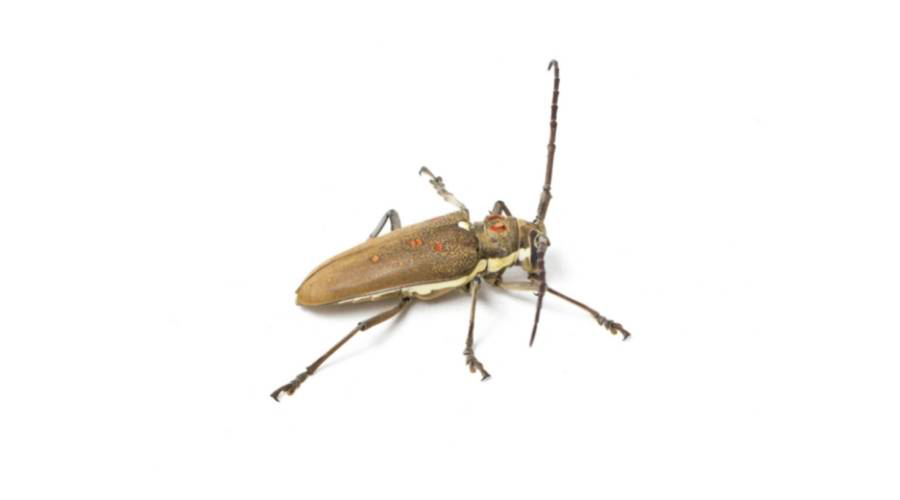
1. Tree Borers
Tree borer is a name used to describe several destructive insect species that bore into tree trunks and branches and are hazardous to the tree’s health. These borers include flat-headed beetles, bark beetles, and clearwing moths. However, the Emerald Ash borer is worth a special mention as it is an exceptionally destructive borer.
These tree borers are forest insects and don’t usually infest furniture or wooden structures. Instead, this group of insects lays its eggs in the bark of a declining tree trunk, typically an old tree that has already sustained fire or insect damage.
The beetle larvae feed on wood. As a result, the tree is consumed from the inside out, causing it to rot. Therefore, tree borers must be dealt with quickly to avoid spreading the infestation to the entire tree.

2. Powderpost, Deathwatch, & False Powderpost Borer Beetles
The powderpost beetle is beneficial when living in a forest as they feed on weak trees but are a nuisance when infesting buildings and homes. Powderpost beetles are easily identifiable as they produce much finer sawdust than other borers and leave tiny, round holes in the wood after they emerge.
The powderpost and deathwatch beetles can cause significant damage to wooden furniture and the buildings’ structure. The adult borers do very little damage to the timber, but the larvae (or woodworms) can reduce the wood to powder.
The beetle larvae feed on the wood until they reach the adult stage when they emerge from the wood by chewing through to the surface and creating round exit holes. Some adults of this species can bore through plaster and plastic that might be covering the wood!
These insects have a one-year life cycle, with the adults appearing around June yearly, so the larvae have a very long feeding period.
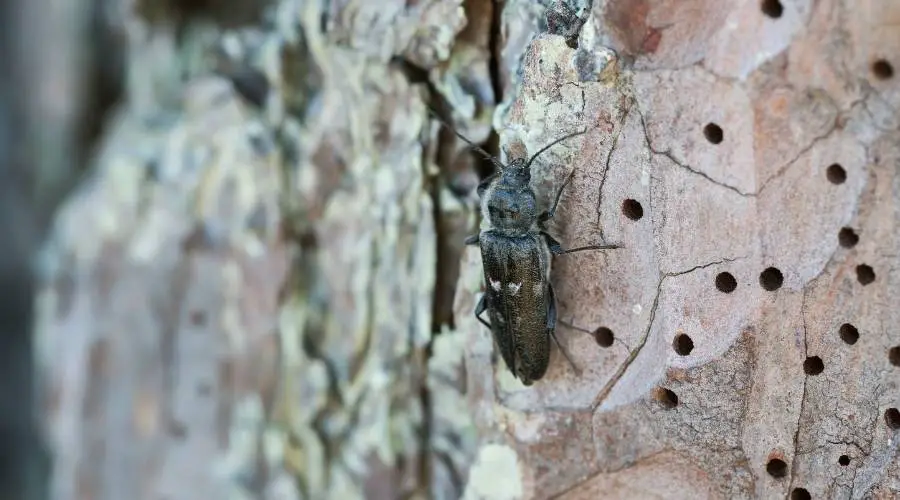
3. Old-House Borer Beetle
This wood borer is less destructive than other borer species and generally found in firewood, attics, basements, and fascia boards. This borer beetle causes damage very slowly over many years.
However, the adult old-house borer beetle is elusive, and finding one is rare. In addition, this borer has a life cycle of between three to twelve years and can re-infest the same wood, so it may be many years before any damage is noticed.
Adults don’t emerge for many years, so the infestation is well established before they appear. The first generation of old-house borer beetles are unlikely to cause much damage, but later undetected generations can cause structural collapse!
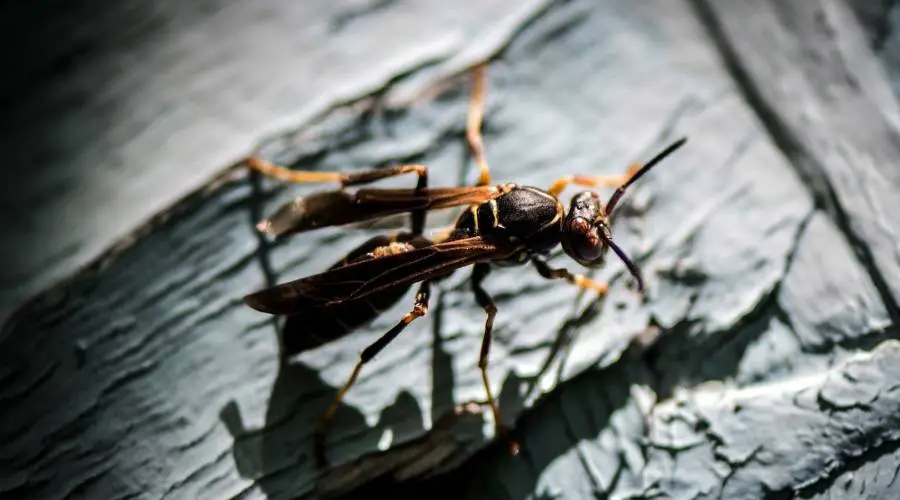
4. Wood Wasps
Wood wasps are not truly wasps, even though they are related to the stinging wasp. Wood wasps are non-stinging wasps that typically infect deciduous trees by boring into the wood. The adults have long projections extending from their bodies, resembling wasp stingers.
They are not stingers but are, in fact, ovipositors, which the female uses to lay her eggs in dead or dying trees. Once the eggs hatch, the larvae bores further into the tree to live for two to three years.
Although wood wasps and horntails do not sting people, they cause a lot of damage to wood and lumber. They can live undetected inside the wood until adulthood, when they chew their way through wood and bark and emerge through an exit hole.
The good news is that these wasps don’t live in a colony, so the number of wasps per nest is relatively small, so even if the wood used in your home does contain wasp eggs, the infestation will be small.
Wood-Borer Identification Guide
We have compiled a quick, handy guide on what to look for when identifying wood borers.
| Powderpost | Deathwatch | Old-House | Wood Wasps | |
|---|---|---|---|---|
| Size | Less than ¼ inch | ¼ to 3/8 inch | ¾ to 1 inch | 1 inch long |
| Color of adult | Reddish-brown to black | Gray-brown, pale hairs on the back | Brownish-black to black | Blue, black, and red/brown |
| Color of larvae | White, cream, dark brown heads | White, cream, dark brown heads | White, cream, three black eyespots | Colorless, dark tip at the rear |
| Antennae | Short | Segmented | 1/3 length of the body | Black |
| Damage ID | Round pinholes Powdery dust | Round holes Fine frass outside holes | Oval holes Frass packed inside tunnels | Round holes. Tiny |
| Habitat | Hardwood | Softwood | Softwood | Deciduous Trees |
Quick Tips For Identifying Wood-Borers:
Use this quick method to identify your problem wood borer.
- The ballpoint pen test. Using a refillable ballpoint pen, insert the tip into the exit hole of the beetle:
- If the pen’s tip fits into the exit hole, it feels like talcum powder – Powderpost borer beetle.
- If the tip of the pen and part of the face fit into the hole, it feels gritty – Deathwatch borer beetle.
- If the entire point of the pen fits into the hole and you cannot move the frass – False Powderpost borer beetle
- To decide the texture of the frass, rub it between your fingers.
How To Spot A Wood-Borer Infestation
Signs that you have a wood-borer infestation could include:
- Tiny holes in the tree trunk or wood
- Larger holes with sawdust next to or below the holes
- Winding tunnels in the wood or lumber
- Wet spots or dark stains in the shape of the number 0 or the letter D
- Discolored leaves in the top part of the tree branches that break close to the trunk
- Eggs in the cracks of wood
- Weak and damaged floorboards
Conclusion
Wood borers can be a problem and are destructive, but you can prevent an infestation by watching for the tell-tail signs of these unwelcome pests when you purchase any wooden item. By identifying the correct borer, you can quickly treat and eliminate them without causing too much damage.
Although they are beneficial insects in the wild as they recycle dead plant matter, most homeowners do not welcome their presence. They could cause damage to your home, which could result in expensive repairs. It makes sense to keep a lookout for these pests and eradicate them before they become a problem.
Get FREE quotes from licensed pest control technicians in your area today. Whether you need spraying for ants, roaches, spiders, ticks, mosquitos, or bed bugs, We Can Help! All technicians are screened, licensed, and insured.


